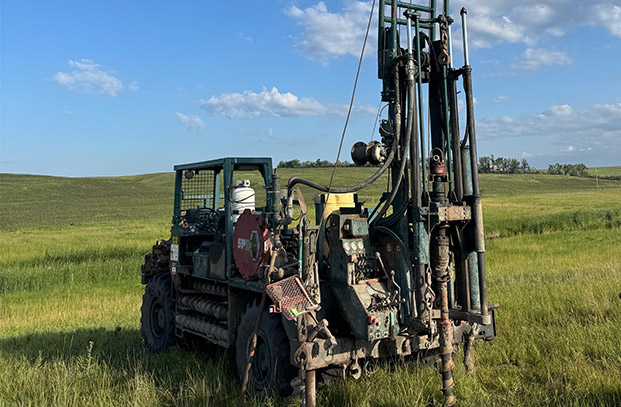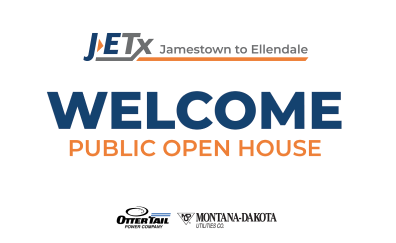Landowner Resources
Partnering with you
Creating a transparent and simple process for landowners allows for ease of conversation and relationship building. We will continue to be partners with landowners through the life of the transmission line.
Rob Frank, Director, Electric Transmission Engineering
Partnering with you
The Project aims to work with each landowner to come to an agreement that works for both parties.
Todd Langston, Manager, Transmission Projects
Respecting your land
Our philosophy is simple: this is your land, and it will remain your land. We're seeking a partnership to use a portion of it to support grid reliability and cost-effective energy for you, your community, and the region. We understand that pole placement is a common concern. Agricultural activities can continue right up to the base of transmission structures, and we're working closely with landowners to identify placements that reduce disruption. Our right-of-way agents are here to support you. If you have questions, just ask—they'll connect you with the right information and resources. We're committed to listening, supporting, and working through this process together.
Easement overview
We're looking to work with landowners to secure a 150-foot-wide easement to safely construct, operate, and maintain the proposed transmission line for an easement payment. Additional temporary workspaces may also be necessary for construction and right-of-way agents will work closely with individual landowners to identify construction needs.
What is an easement?
An easement is an agreement that provides Otter Tail Power Company and Montana-Dakota Utilities Co. the rights to access, construct, operate, and maintain transmission lines and associated facilities (e.g., structures, wires) on private property. Our goal is to work closely with landowners to resolve concerns and reach voluntary agreements.
What's the difference between an easement and an option?
An option is a binding document and payment that gives Otter Tail Power and Montana-Dakota Utilities the right to choose to acquire an easement within a specific period of time for the project.
What is a right of way?
Right of way is a portion of land needed for the construction, operation, and maintenance of the transmission line. Typically, a width of 150 feet is needed for a 345-kV transmission line. Right of way is typically secured through negotiation and acquisition of an easement agreement.
What landowners can expect
Our typical process
All landowners' experiences will be unique in order to accommodate individual needs, but generally, they can expect the following to occur:
- Landowners will be notified that an easement may be needed on their property.
- A right-of-way agent will present the landowner an easement.
- We are committed to working with landowners to address questions or concerns, coming to an agreement to grant an easement.
- Pending approval from the North Dakota Public Service Commission, the utilities will construct, operate, and maintain the transmission line.
Our anticipated schedule
We're working with landowners to secure 150-foot-wide easements to safely construct, operate, and maintain the proposed transmission line.

- 2024 - Continue acquiring options for easements, right of entry for temporary access and various environmental surveys
- Early 2025 - Ongoing coordination with right of way team through project completion and restoration, and execute options for easement agreements
- Mid 2025 - File Route Permit Application
- 2026-2027 - Anticipated North Dakota Public Service Commission decision, starting line construction, and vegetation management
- 2028 - Line energized
- 2029 - Land restoration
- Updates in August 2025; schedule is subject to change
During construction, our team will work with landowners to perform any necessary repairs and compensate landowners for damage to crops. Please visit our FAQs for more information.
View our progress
We've come a long way since 2023! Swipe or scroll to view our progress.
-
Field surveys
Field surveys for cultural resources and soil borings are underway. These help the team verify or collect new information about the Proposed Route and corridor to help identify and minimize impacts. Reach out to your right-of-way agent to learn more. -
Planning & processing
We've attended more than 65 meetings with townships, cities, and counties as well as numerous meetings and conversations with landowners to gather routing input and feedback to review and consider during the routing process. -
Landowner discussions
Hosting right of entry conversations to continue field surveys, which may can require access to private property to investigate areas for sensitive species, habitats, and resources. -
Round 2 open houses
In September 2023, we hosted a second round of open houses with 153 attendees. We promoted these events with targeted newspaper and social media ads. -
Round 1 open houses
Between June-July 2023, we hosted a round of open houses with 101 attendees. We promoted these events with targeted newspaper and social media ads.
Landowner FAQs
Right of way is a portion of land needed for the construction, operation, and maintenance of the transmission line. Typically, a width of 150 feet is needed for a 345-kV transmission line. Right of way is typically secured through negotiation and acquisition of an easement agreement.
To assess potential routes and conduct the necessary environmental, engineering, and geologic studies/surveys, right-of-way agents will work with landowners to acquire a temporary right-of-entry agreement. This agreement does not give permission for construction.
An easement is an agreement that provides Otter Tail Power Company and Montana-Dakota Utilities Co. the rights to access, construct, operate, and maintain transmission lines and associated facilities (e.g., structures, wires) on private property. Our goal is to work closely with landowners to resolve concerns and reach voluntary agreements.
An option for an easement is a binding document that gives Otter Tail Power Company and Montana-Dakota Utilities Co. the right to choose to acquire an easement within a specified time period (e.g., a number of years) for the project. Options are paid at the time landowners sign them.
Yes. If crops are damaged during construction or future maintenance activities, landowners will be compensated.
Prices and expected yield for damaged or destroyed crops will be based on the current market of the crops. Current value will be based on the average spot price for the commodity per the website of the three nearest elevators.
Yields will be based on the previous three years' averages for that particular crop. Data for yield calculations will be found on the USDA's National Agricultural Statistics Service website.
Landowners may continue to use the property in ways that are compatible with the transmission line as long as the use does not interfere or endanger the transmission line. Buildings, structures, pumps, wells, swimming pools, and trees are examples of things not allowed within easement areas for the safe construction, operation, and maintenance of the transmission line. Right-of-way agents can work with landowners to help determine allowed and unallowed uses within easement areas.
No. The easements for JETx are limited to the "Electric Line Facilities" as defined in the agreements and the activities described in the agreements with landowners. The easements do not grant the project owners to use landowners' properties for purposes unrelated to those described in the agreements.
This type of facility typically does not have an impact on property use which would affect land valuation. For more information, reach out to your county assessor.
Construction areas that are not needed for ongoing operation and maintenance of the new transmission line will be restored to their previous condition, to the extent possible. The reclamation team will take direction from the landowner regarding needs and specifications for each parcel with grass or hay. Construction materials will also be removed.
The North Dakota Public Service Commission (PSC) requires reclamation, fertilization, and reseeding to be done according to Natural Resources Conservation Service recommendations. Any landowner requests that deviate from these recommendations will require JETx to first get approval from the PSC.
Once the line is energized, maintenance crews will periodically inspect, repair and maintain the transmission line within the right of way.
Webpage disclaimer:
The information on this page is intended for general purposes only and is not intended as legal advice and circumstances may vary for each landowner and property.
Library & FAQs
Download project and permitting documents and find answers in our FAQ section.
Learn moreMap & Routing
Learn more about how we route a transmission line and explore our interactive map.
Learn more Landowners will be notified that an easement may be needed on their property.
Landowners will be notified that an easement may be needed on their property.
 A right-of-way agent will present the landowner an easement.
A right-of-way agent will present the landowner an easement.
 We are committed to working with landowners to address questions or concerns, coming to an agreement to grant an easement.
We are committed to working with landowners to address questions or concerns, coming to an agreement to grant an easement.
 Pending approval from the North Dakota Public Service Commission, the utilities will construct, operate, and maintain the transmission line.
Pending approval from the North Dakota Public Service Commission, the utilities will construct, operate, and maintain the transmission line.
 During construction, our team will work with landowners to perform any necessary repairs and compensate landowners for damage to crops. Please visit our FAQs for more information.
During construction, our team will work with landowners to perform any necessary repairs and compensate landowners for damage to crops. Please visit our FAQs for more information.



